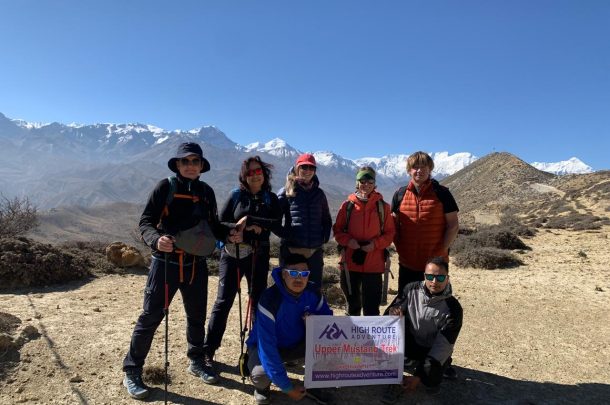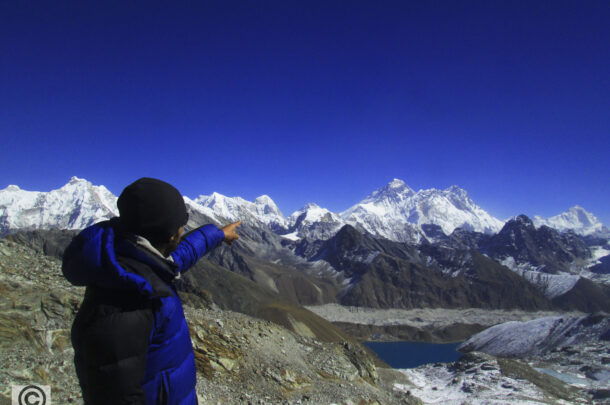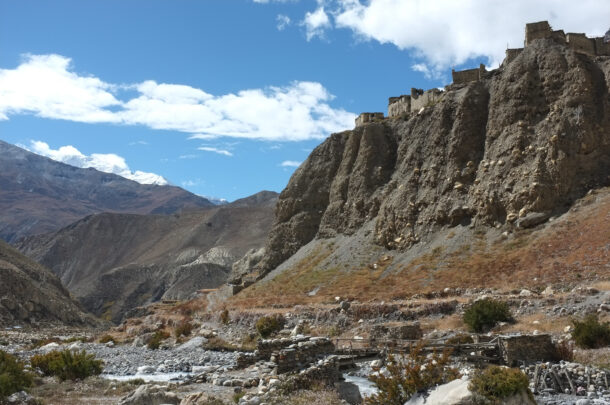The Everest Base Camp Trek is one of Nepal’s most legendary and life-changing treks. It offers a thrilling mix of natural beauty, high-altitude adventure, and deep cultural experiences. With the mighty Mount Everest (8,848.86m) constantly in view, trekkers journey through lush forests, raging rivers, Sherpa villages, and sacred monasteries. This trek is more than just reaching the base of the world’s tallest mountain—it’s a spiritual and physical journey through the heart of the Khumbu region.
The trek begins with a scenic and adrenaline-pumping flight from Kathmandu to Lukla, one of the most thrilling airports in the world. From Lukla, the trail follows the Dudh Koshi River, passing charming villages like Phakding and Monjo before entering Sagarmatha National Park.
Key stops along the way:
One of the major highlights of the Everest Base Camp Trek is the awe-inspiring views of Mount Everest (8,848.86m) and surrounding peaks like Lhotse, Nuptse, Ama Dablam, and Thamserku. The panoramic Himalayan scenery begins as soon as you land in Lukla and keeps getting better each day. Trekkers are rewarded with close-up views of Everest, especially from Kala Patthar (5,545m), known for its stunning sunrise. The snow-covered peaks, glaciers, and icefalls create unforgettable visuals throughout the journey.
Your EBC Trek adventure starts with a scenic flight from Kathmandu to Lukla airport, one of the most exciting and scenic flights in the world. Flying over deep valleys and high ridges with views of the Himalayas is a unique experience in itself. The short airstrip in Lukla, perched on a hillside, sets the tone for the adrenaline-packed trek ahead. It’s not just transportation—it’s a memory in the making.
The Everest Base Camp route winds through beautiful Sherpa villages like Namche Bazaar, Tengboche, and Pangboche, giving trekkers a glimpse into traditional mountain life. The Sherpa people, known for their resilience and mountaineering skills, are warm, welcoming, and deeply spiritual. You’ll see colorful prayer flags, Buddhist stupas, and monasteries along the trail. Their rich cultural heritage adds depth to the trekking experience.
One of the spiritual highlights of the trek is a visit to Tengboche Monastery, the largest Buddhist monastery in the Everest region. Located at 3,867 meters, it offers incredible views of Ama Dablam and Everest. Trekkers often receive blessings from the resident monks before continuing their journey. The peaceful ambiance and fluttering prayer flags create a sacred moment amid the Himalayan wilderness.
Climbing Kala Patthar, meaning “Black Rock,” is one of the most rewarding parts of the trek. It offers the best panoramic view of Mount Everest and surrounding peaks at sunrise. The climb is short but steep, and the view at the top is absolutely breathtaking. Watching the golden rays hit the summit of Everest is a bucket-list experience for every trekker.
As you approach Everest Base Camp, you walk alongside the massive Khumbu Glacier and get a glimpse of the dangerous and fascinating Khumbu Icefall. These natural wonders are ever-changing due to shifting ice and melting patterns. It’s a stark reminder of the raw power of nature at high altitude. The terrain here is rugged, surreal, and deeply captivating.
The Everest trekking trail passes through the protected area of Sagarmatha National Park, home to rare wildlife, alpine forests, and glaciers. Designated a UNESCO World Heritage Site, it offers a pristine natural environment to explore. Trekkers may spot Himalayan tahrs, musk deer, snow pigeons, and if lucky, even the elusive snow leopard. The park adds a rich layer of biodiversity to the trekking journey.
At the end of each trekking day, you rest in local teahouses that offer simple accommodation and warm meals. This authentic part of trekking in Nepal allows you to connect with other trekkers and enjoy Nepalese hospitality in remote mountain villages. Typical meals include Dal bhat, noodle soup, and momos, providing the energy needed for the next day’s hike. Teahouse stays are part of what makes the Everest Base Camp Trek a culturally rich and immersive experience.
The Everest Base Camp trek is a moderately to highly challenging trek, suitable for those with a good level of fitness and a sense of adventure.
Trek details:
If you want a trekking experience that’s both adventurous and comfortable, the Luxury Everest Base Camp Trek is definitely worth reading about.Our Everest Base Camp Trek package costs $1495 USD per person. Special discounts are available for groups. You can book in advance for the years 2026/2027, and at High Route Adventure, we also accept last-minute bookings.
Optional upgrades like private rooms, hot showers, and helicopter return can be arranged.
At High Route Adventure, we have over a decade of experience guiding trekkers in the Everest region. We’re committed to your safety, comfort, and cultural immersion.
What we offer:
For those who seek luxury during the Everest Base Camp Trek, you can check out our Luxury Everest Base Camp Trek package.| Permit | Description | Approximate Cost | Where to Obtain |
| TIMS Card | Trekker registration permit | $20 (individual) | Nepal Tourism Office or Trekking Agency |
| Sagarmatha National Park Permit | Entry permit for Everest region | $30 | Department of National Parks |
Note: These permits are arranged free of cost by High Route Adventure when you book the package with us.
Touching down at Tribhuvan International Airport, our representative will be waiting to give you a warm welcome. You could search for a placard with your name or company's name to hold on in front of the terminal. After getting you directly to the hotel. After freshening up from the day's journey, you will be introduced to other staff members including your guides for the trip.
If you have any questions regarding your trek, you can talk with your guide. Following a short briefing session we wrap up all the activities for the day and you are free to head down to the local markets to enjoy the pleasant evening. Overnight Stay at Hotel.
A thrilling start to the journey, we begin our Himalayan adventure with a scenic flight to the picturesque town of Lukla. Flying high over lush green valleys and the majestic Himalayas before touching down at one of the most thrilling airstrips around the world is an enthralling experience. Taking a brief stop at the Sherpa town, we set off on the trail heading towards Phakding, our stopover for the night. The trail to Phakding sets off through the vibrant settlements of Cheplung and Nachipang before meeting up with the banks of the Dudh Koshi River at Koshiguan. The final stretch of the journey takes us alongside the river banks until we reach the quiet village of Phakding.

An early start to the day, we continue our journey alongside the banks of Dudh Koshi River heading past a series of suspension bridges including the famed Hillary Suspension Bridge. Continuing our journey through the vibrant hamlet of Thulo Ghamela, we enter lush green forests leading toward Bengkar. The next stretch of the journey takes us past Monjo and Jorsalle, with the latter marking our entry to Sagarmatha National Park. Leaving the riverbank, the trail quietly ascends through tranquil alpine forests to Namche. Overnight in Namche.
An early start to the day, we continue our journey alongside the banks of Dudh Koshi River heading past a series of suspension bridges including the famed Hillary Suspension Bridge. Continuing our journey through the vibrant hamlet of Thulo Ghamela, we enter lush green forests leading toward Bengkar. The next stretch of the journey takes us past Monjo and Jorsalle, with the latter marking our entry to Sagarmatha National Park. Leaving the riverbank, the trail quietly ascends through tranquil alpine forests to Namche. Overnight in Namche.

The first of our acclimatization days, today we take some time off at Namche enjoying the picturesque beauty of the bustling Sherpa town. Known as the Gateway to Everest, the town is always buzzing with locals and trekkers heading in and out of the region. After an early morning tour around the stunning Namche, we set off for our acclimatization hike to the neighboring villages of Khumjung and Khunde. Beholding stunning Himalayan views on the horizon, the journey ascends through picturesque hills and rivers to reach Khumjung, which houses the Yeti Skull Monastery. On our way back.
to Namche, we also visit the beautiful Sherpa village of Khunde whilst enjoying the mountain vista on the backdrop. Overnight in Namche.

Today we head out of Namche and make our way to Tengboche. The journey is a pleasant one with the majestic summit of Ama Dablam (6812m) accompanying us throughout the hilly trail. Exiting Namche, we ascend past the Everest View Hotel heading towards the village of Sanasa. Past Lawi Schyasa and Tashing, the trail crosses the Dudh Koshi River and brings us to Phunge Thenga. A short ascend through the picturesque valley takes us to Tengboche. we are staying at the vibrant hamlet, we visit the Tengboche Monastery, which is one of the oldest and most sacred monasteries in the region.
Overnight in Tengboche.

Leaving behind the tree lines, Descending to the hamlet of Deboche, our journey takes us alongside the banks of the Imja River, heads past Milingo, and reaches Pangboche. the trail continues to ascend with majestic views of the Himalayas. Enjoying the picturesque vistas of Ama Dablam (6812m), Lingtren (6749m), and Changtse (7543m) amongst others, we ascend to reach Shomare. We then continue our journey past small Chortens adorned with prayer flags to reach the village of Worship. A steep climb afterward takes us to Dingboche, from where we can witness a surreal view of Everest (8848m), Lhotse (8516m), and Ama Dablam (6812m). Overnight in Dingboche.

Today we take some time off at Dingboche, making sure our bodies are well adapted to the increasing altitude. Often referred to as the summer valley, the hamlet of Dingboche is a summer settlement used by yak herders. For our acclimatization hike, we can ascend to the nearby hills for a captivating Himalayan view of the entire Everest range. We can spend the rest of the day exploring the village and getting acquainted with the local Sherpa way of life. Overnight in Dingboche.
Traversing through the Himalayan terrain, we begin our adventure early setting off towards Lobuche, today’s stopover. Leaving Dingboche, the rugged Himalayan trail ascends with a continuous view of majestic Himalayas as we head to Dughla. Crossing a bridge near the waterfall in Dughla, we continue to ascend until reaching Pheriche. The picturesque views of Nuptse (7861m), Changtse (7543m), and Lhotse (8516m) gaze at us as we head over to the small settlement of Lobuche. Overnight in Lobuche.
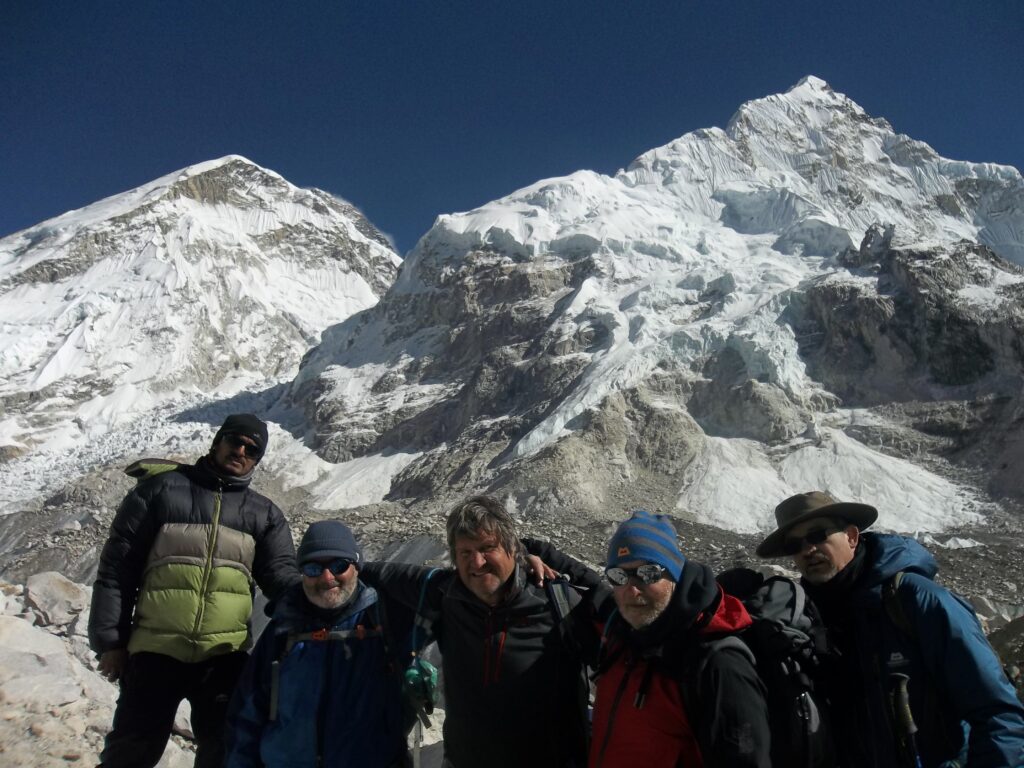
We leave Lobuche early today so that we can begin our Himalayan adventure ascending to Gorakshep and then to Everest Base Camp, our ultimate destination. The trail ascends through the lateral moraines of Khumbu Glacier as we navigate through the rugged Himalayan trail. The Himalayas appear closer now as we ascend to reach Everest Base Camp via Gorakshep. En route, we come across prayed flag-laden memorial Chortens devoted to fallen Sherpas. Upon reaching the foot of the world's tallest mountain, we take some time off to savor the thrill of witnessing the stunning Himalayan panorama unfold in front of our eyes. Later we head back to Gorakshep for the overnight stay.
We begin our day before sunrise today so that we can hike up to Kalapatthar (5545m) and enjoy a jaw-dropping sunrise over the gigantic Everest. Drenched in the rays of the early morning sun, the summits of Everest (8848m), Nuptse (7861m), Changtse (7543m), Lhotse (8516m), Ama Dablam (6812m), and others make for an unforgettable Himalayan panorama. Afterward, we descend back to Gorakshep before setting off to the village of Pheriche for the night. Overnight in Pheriche.
One of the longer days of our journey, today we descend back to Namche for the night. The journey is a pleasant one as we make our way through the pleasant hilly trail with the majestic Himalayas on the backdrop. The trail descends from Pheriche to reach Dughla, before setting off toWorshyo and Shomare. Meeting up with the stunning Imja River past the hamlet of Pangboche, the trail takes us to Deboche. We then enter lush green forests once again and make our way back to Phunge Thenga to once again meet up with the Dudh Koshi River. The final stretch of the day’s trek takes us back to Tengboche before descending to Namche. Overnight in Namche
Leaving Namche behind, the trail once again descends through the alpine forests with Kusum Kanguru (6367m) shining brightly at us. The journey is a pleasant one that moves us alongside the Dudh Koshi River to reach Jorsalle exiting Sagarmatha National Park. Past Jorsalle, the trail takes us to Monjo, Chumoa, and Bengkar which are lined with small monasteries and Chortens, making the trail both vibrant and calming. The hilly trail gradually descends to Phakding before making a steep climb to reach Lukla. Overnight in Lukla.
Today we relive the thrill of the Lukla airstrip once again as we board our flight back to the capital city. Bidding goodbye to the majestic Himalayas, we fly above gorgeous hills and massive river networks until reaching Kathmandu. You will be dropped at your hotel upon arrival. For the rest of the day, you can explore Kathmandu on your own and visit the nearby landmarks like Basantapur Durbar Square and Swayambhunath. Overnight at the hotel in Kathmandu.
Our representatives will drop you back at Tribhuvan International Airport a few hours before your scheduled flight back home. We hope you had a lovely time with us and we look forward to seeing you again.
Collaborate with our specialists to create a unique itinerary.
Choose from our scheduled group trips below, or contact us to plan a private or family adventure tailored to your schedule.
The Everest Base Camp Trek - 14 Days starts with a scenic flight to Lukla, the main entry point to the Khumbu region. During the peak seasons (spring and autumn), flights to Lukla operate from Manthali Airport in Ramechhap, which involves a 4 to 5-hour early morning drive from Kathmandu. In the off-season (winter and summer), you can enjoy a direct flight from Kathmandu to Lukla. If you're trekking during the busy months, it's best to schedule extra time for the drive to Manthali to avoid any travel issues.

During the Everest Base Camp Trek 14 Days, you will stay in local teahouses or mountain lodges along the trail. High Route Adventure will arrange shared twin rooms for all trekkers. These rooms are simple but comfortable, with basic bedding and shared bathrooms.
In lower-altitude villages like Phakding, Namche Bazaar, and Tengboche, you may find additional services like hot showers, Wi-Fi, and charging ports. If you prefer more privacy, room upgrades are available at certain places for an extra cost (subject to availability). At higher altitudes such as Lobuche and Gorakshep, the facilities become more basic, so bringing a warm sleeping bag is highly recommended.
During the Everest Base Camp Trek, High Route Adventure will provide three meals a day – breakfast, lunch, and dinner – at local teahouses along the trail. Meals are freshly prepared and typically include options like dal bhat, noodles, fried rice, pasta, soup, pancakes, and eggs. Breakfast usually comes with tea or coffee, and lunch and dinner offer both Nepali and international choices.
Please note that hot water, extra beverages (like soft drinks, coffee, and bottled juices) are not included and must be paid for separately. We recommend drinking boiled or purified water and keeping your body hydrated throughout the trek.
Staying hydrated is very important during the Everest Base Camp Trek. You can find drinking water at teahouses and small shops along the trail. However, bottled water gets more expensive as you go higher. To save cost and reduce plastic waste, we recommend using refillable water bottles and water purification tablets, filters, or UV sterilizers.
High Route Adventure does not provide bottled water, but you can refill boiled or filtered water at teahouses for a small fee. Always make sure your water is safe before drinking to avoid stomach problems at high altitude.
Altitude sickness is a common challenge on the Everest Base Camp Trek due to the high elevations. To prevent this, proper acclimatization is essential. The trek itinerary includes rest days in key places like Namche Bazaar to help your body adjust to the thinner air. Symptoms of altitude sickness can include headaches, nausea, dizziness, and shortness of breath.
To reduce risks, drink plenty of water, avoid alcohol, and ascend slowly. If symptoms worsen, it’s important to descend immediately. Carrying medications like Diamox can help, but always consult your doctor before use. Following acclimatization guidelines ensures a safer and more enjoyable trek to Everest Base Camp.
| Place | Altitude | Oxygen Level |
| Lukla | 2840m/9318ft | 73% |
| Namche | 3442m/11287ft | 64% |
| Dingboche | 4410m/14469ft | 58% |
| Lubuchhe | 4910m/16109ft | 53% |
| Gorakshep | 5140m/16864ft | 51% |
| Everest Base Camp | 5364m/17598ft | 50% |
| Kala Patthar | 5500m/18209ft | 50% |
The best time to go for the Everest Base Camp Trek is during the spring (March to May) and autumn (late September to November) seasons. These months offer clear skies, moderate temperatures, and stunning mountain views, making trekking comfortable and safe. Spring brings blooming rhododendrons and warmer weather, while autumn has stable weather and less chance of rain.
The monsoon season (June to August) is generally avoided due to heavy rain and slippery trails, and the winter months (December to February) are very cold with snow, which can make the trek challenging. Planning your trek during the peak seasons ensures better weather, more open teahouses, and breathtaking scenery.
We provide an experienced guide and porter free of cost for every trekker. For groups larger than 10, we also assign an assistant guide to ensure extra care and smooth management. Each porter carries up to 20 kg and serves two trekkers. All guides and porters are fully insured, and their wages are included in the trek package price—so there are no extra fees. You can tip based on their service and your satisfaction after the trek.
We also offer solo guided Everest Base Camp treks for independent trekkers seeking personal support.
For the best mobile network coverage during the Everest Base Camp Trek, using NTC (Nepal Telecom) SIM is recommended. However, due to the high altitude and remote locations, mobile network signals may still be weak or intermittent.
Wi-Fi is available at most teahouses along the trail for a fee, typically ranging from USD 1 to 3 per hour, which you need to pay separately.
You can buy an NTC SIM card upon arrival at the Kathmandu airport for about 1 USD, and data packages generally cost around 10 USD for sufficient internet access during your trek.
All trekkers heading to the Everest Base Camp must have travel and medical insurance that covers high-altitude trekking in Nepal. Insurance is crucial for your safety, as you can face health issues like diarrhea, acute mountain sickness (AMS), or unexpected accidents.
In case of emergencies, such as needing a helicopter evacuation, your insurance will cover medical bills and rescue costs, depending on your policy.
Travel insurance also protects you if your trek is delayed or canceled due to bad weather, especially important for flights to and from Lukla, which often depend on clear skies. Flight delays or cancellations can disrupt your itinerary or leave you stranded in Lukla for several days. Having insurance helps cover extra expenses during such situations.
Note: Do you need to know the travel insurance for trekking and peak climbing in Nepal? please click here
This map shows the classic 14-day Everest Base Camp Trek route, starting from Lukla and passing through key stops like Phakding, Namche Bazaar, Tengboche, Dingboche, Lobuche, and Gorakshep, before reaching the iconic Everest Base Camp. The return journey follows the same path back to Lukla. The map highlights trekking distances, elevation gains, and rest days for acclimatization.
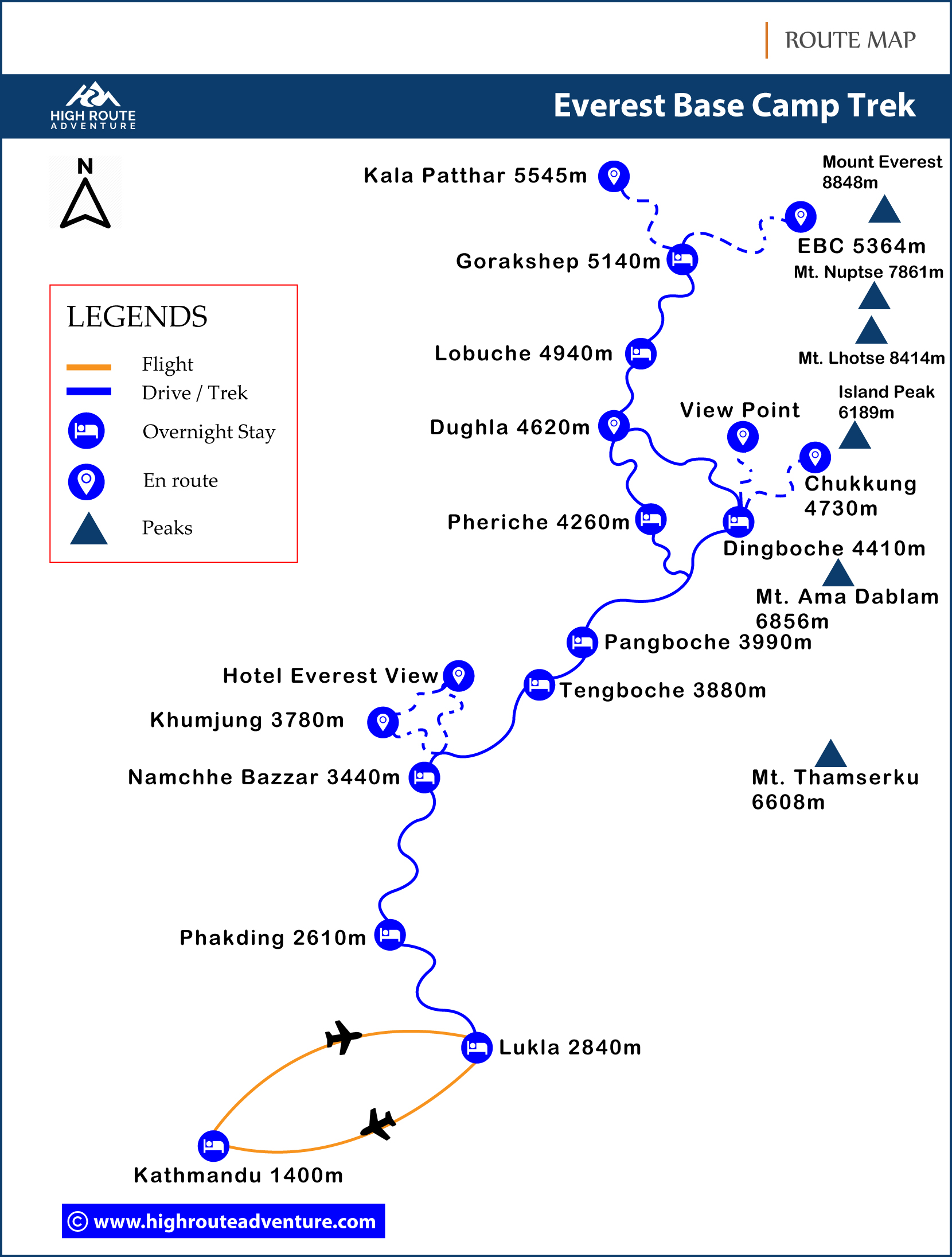
Whether you're trekking solo or with a guide, this detailed EBC trek packing guide will help you pack everything you need—without carrying too much.
The weather changes quickly in the Himalayas. That’s why layering is the smartest way to dress. You’ll need clothes for warm, cold, windy, and even snowy conditions.
Footwear is critical for a safe and comfortable trek. Make sure everything is well broken-in before you go.
Choose the right bags to carry your gear efficiently.
Lodges (tea houses) provide basic bedding, but it’s better to carry your own for warmth and hygiene.
Bathrooms are basic. Some lodges don’t have running water. Bring what you need to stay clean and comfortable.
You’ll be trekking in remote areas, so it's best to bring your own medical kit.
There’s limited charging on the trail (and it costs extra). Bring what you need but pack light.
These small items are super useful on the trail.
Always carry originals and photocopies of your essential documents.

